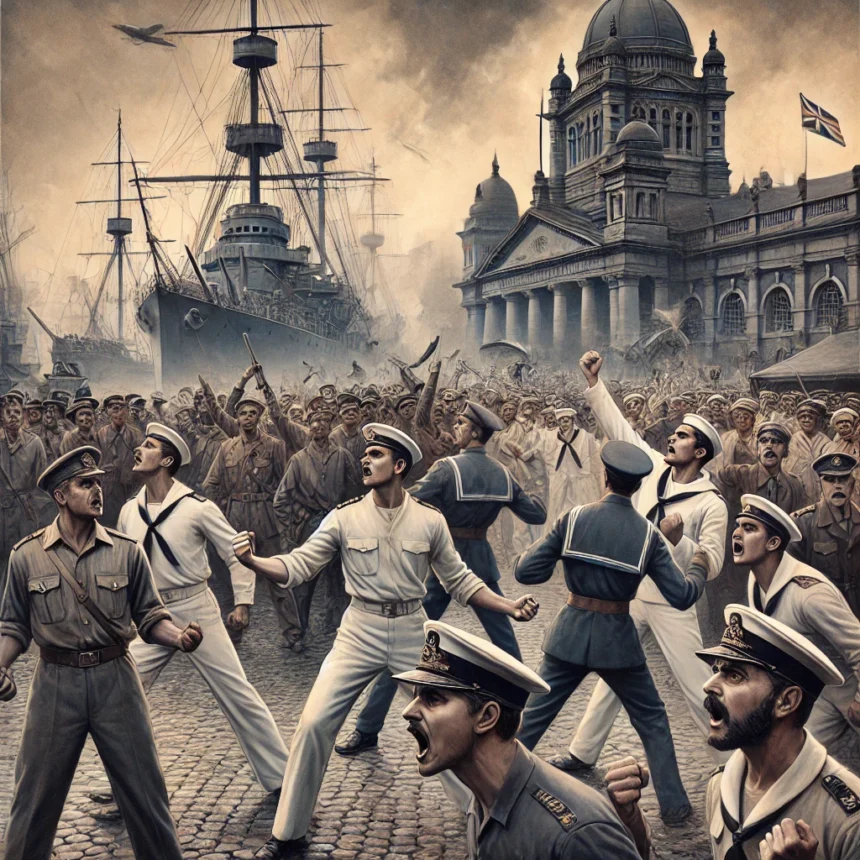Royal Navy Revolt Mumbai: The Fire for Indian Independence
Spark of the Royal Navy Revolt Mumbai
As we delve into the annals of Indian history, this week’s focus illuminates a critical yet often overlooked chapter in India’s quest for independence—the Royal Indian Navy (RIN) Revolt of 1945. This event was not merely a demonstration of the frustrations felt by Indian naval personnel under colonial rule; it was a crucial catalyst that influenced the trajectory of India’s independence movement. Known as the Royal Navy Revolt Mumbai, this uprising challenged the traditional narratives of non-violent struggle, showcasing a more confrontational stance against British authority that played a significant role in securing India’s freedom.
The Prelude to Rebellion
As the world emerged from the devastation of World War II, seismic shifts in global power dynamics were mirrored by changing sentiments within India. This period set the stage for the Royal Navy Revolt Mumbai, marked by a profound sense of disillusionment and burgeoning nationalist aspirations among Indian servicemen.
The Royal Indian Navy, which comprised over 20,000 sailors, became a focal point of discontent. These sailors, many of whom had loyally served the British during the war, returned only to face discrimination and harsh treatment under the same regime they had fought to protect. Their grievances extended beyond poor wages and racial discrimination; they felt a deep sense of betrayal over unmet expectations for better treatment and broader political change.
Historically, this sense of betrayal was partly fueled by the expectations set during the war. The Indian political leadership, particularly the Congress Party, perceived their support of the British war effort as a strategic move that would lead to political concessions and eventually independence. This belief was bolstered by the British promises of post-war reforms and greater self-governance, articulated most notably in the Cripps Mission of 1942. However, these promises were vague and ultimately fell short of the full independence that was expected, leading to widespread frustration and disillusionment.
This frustration was not just about unfulfilled promises but also about the immediate post-war treatment of Indian servicemen and the broader political repressions reminiscent of the actions taken after World War I, which had culminated in tragic events like the Jallianwala Bagh massacre. The Royal Navy Revolt Mumbai can thus be seen not only as a reaction to immediate grievances but also as an expression of deep-seated resentment against continuing colonial rule and broken assurances. The revolt was emblematic of the shifting dynamics in colonial India, signaling a critical juncture in the nation’s struggle for independence.
Spark and Spread: Background and Royal Navy Revolt Mumbai
The immediate catalyst for the Royal Navy Revolt Mumbai on December 1, 1945, was the arrest of a ratings’ leader who had voiced complaints about the substandard food at HMIS Talwar, the signal training establishment in Bombay. This incident, however, was merely the spark in a powder keg of long-simmering discontent among the sailors. Their grievances were manifold, encompassing demands for better food, equal pay with their British counterparts, and more respectful treatment by their superiors.
The seeds of unrest had been sown much earlier and were deeply rooted in broader issues of racial discrimination and unequal treatment. The atmosphere among the naval ranks was charged with a potent mix of nationalist fervor and a sense of injustice, conditions ripe for rebellion.
Moreover, there was significant brewing anger among the Indian populace and servicemen towards the British handling of the Azad Hind Fauj (Indian National Army, INA) personnel. The INA, which had fought against the British during the war with the support of Japan, was largely composed of Indian prisoners of war who had chosen to fight for India’s freedom under Subhas Chandra Bose’s leadership. After the war, the British began arresting and trying INA members, which was perceived as a betrayal and a blatant disregard for their patriotic service to the nation. This treatment ignited further discontent within the ranks of the Indian armed forces and among the general public, who saw these fighters as heroes of the independence movement.
The revolt, initially localized in Bombay, quickly spread like wildfire to other naval establishments across India, including Karachi, Madras, and Calcutta. It soon involved 78 ships, 20 shore establishments, and 20,000 sailors. The widespread nature of the revolt and the rapidity with which it spread underscored the deep-seated discontent that permeated the Royal Indian Navy. It also received considerable support from the public and political entities such as the Indian National Congress and the Muslim League, reflecting its broad appeal and the nationalist sentiments that had reached a boiling point.
The Royal Navy Revolt Mumbai was not just a reaction to immediate issues within the naval establishments; it was also a manifestation of the broader anti-colonial sentiment and a critical moment in the struggle for Indian independence. The support it garnered from various sectors of society illustrated the unified stance against British colonial rule, marking a pivotal moment in the history of India’s freedom movement.
Government’s Reaction to the Royal Navy Revolt Mumbai
The British response to the Royal Navy Revolt Mumbai was marked initially by surprise, swiftly followed by stringent countermeasures. The British authorities deployed the Royal Navy to quell the uprising and arrested several sailors involved in the mutiny. However, the seeds of dissent had already germinated, profoundly shaking the foundations of British authority in India. The forceful assertion by Indian political leaders and the palpable fear of a widespread armed uprising compelled the British to engage in negotiations.
Significance and Legacy of the Royal Navy Revolt Mumbai
The significance of the Royal Navy Revolt Mumbai lies not only in its timing—shortly after the end of World War II—but also in its profound political context. This revolt demonstrated to the British and the world at large that Indian forces were not only capable of organizing a revolt against the Empire but were also increasingly unwilling to accept subjugation. Crucially, it underscored the diminishing efficacy of British colonial rule and amplified the burgeoning desire for independence among the Indian populace.
Contrary to the popular belief and widely propagated opinion that M.K. Gandhi’s non-violent resistance solely secured Indian independence, the Royal Navy Revolt Mumbai played a pivotal role in compelling the British to reconsider their stance on India. This uprising served as a stark reminder that the loyalty of the armed forces—the backbone of any colonial regime—could no longer be taken for granted. It was a critical realization that significantly undermined the existing colonial power structure.
Historians argue that the revolt not only accelerated the British decision to leave India but also marked a crucial turning point in the Indian independence movement. The revolt galvanized the Indian masses, fostering a sense of unity that transcended religious and regional divides. This unity was pivotal, as it presented a united front against colonial rule, significantly impacting the dynamics of power and resistance.
In essence, the Royal Navy Revolt Mumbai was a seminal event that signaled the imminent end of British rule in India. By demonstrating the capabilities and resolve of the Indian servicemen and highlighting the widespread national support for the revolt, it effectively hastened the British departure and contributed to the achievement of Indian independence.
Reflecting on the Royal Navy Revolt Mumbai
As we reflect on the Royal Navy Revolt Mumbai, it becomes clear that this was not just a reaction to the immediate injustices faced by the Royal Indian Navy but a manifestation of a broader anti-colonial sentiment that was pivotal in the struggle for Indian independence. The revolt demonstrated the capability and resolve of Indian servicemen, highlighting the widespread national support for a break from British rule and contributing significantly to the hastening of the British departure. By reevaluating this event, we recognize the complex layers of courage, negotiation, and strategic planning involved and understand that the path to India’s independence was multifaceted, driven by both non-violent movements and compelling acts of defiance.
Feature Image: Click here to view the image.
Top Searched #Tags: #RoyalNavyRevoltMumbai #IndianIndependence #NavalMutiny1945 #ColonialIndia #FreedomStruggle
Visit our Youtube Channel by clicking here.
Click here to visit the related page on Medium.com



Leave a Reply